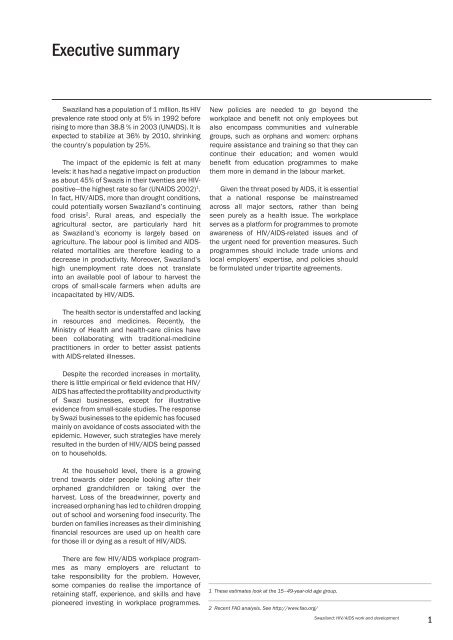HIV/AIDS+WORK Swaziland
HIV/AIDS, work and development - (NERCHA), the Info Centre
HIV/AIDS, work and development - (NERCHA), the Info Centre
- No tags were found...
Create successful ePaper yourself
Turn your PDF publications into a flip-book with our unique Google optimized e-Paper software.
Executive summary<strong>Swaziland</strong> has a population of 1 million. Its <strong>HIV</strong>prevalence rate stood only at 5% in 1992 beforerising to more than 38.8 % in 2003 (UNAIDS). It isexpected to stabilize at 36% by 2010, shrinkingthe country’s population by 25%.The impact of the epidemic is felt at manylevels: it has had a negative impact on productionas about 45% of Swazis in their twenties are <strong>HIV</strong>positive—thehighest rate so far (UNAIDS 2002) 1 .In fact, <strong>HIV</strong>/AIDS, more than drought conditions,could potentially worsen <strong>Swaziland</strong>’s continuingfood crisis 2 . Rural areas, and especially theagricultural sector, are particularly hard hitas <strong>Swaziland</strong>’s economy is largely based onagriculture. The labour pool is limited and AIDSrelatedmortalities are therefore leading to adecrease in productivity. Moreover, <strong>Swaziland</strong>’shigh unemployment rate does not translateinto an available pool of labour to harvest thecrops of small-scale farmers when adults areincapacitated by <strong>HIV</strong>/AIDS.New policies are needed to go beyond theworkplace and benefit not only employees butalso encompass communities and vulnerablegroups, such as orphans and women: orphansrequire assistance and training so that they cancontinue their education; and women wouldbenefit from education programmes to makethem more in demand in the labour market.Given the threat posed by AIDS, it is essentialthat a national response be mainstreamedacross all major sectors, rather than beingseen purely as a health issue. The workplaceserves as a platform for programmes to promoteawareness of <strong>HIV</strong>/AIDS-related issues and ofthe urgent need for prevention measures. Suchprogrammes should include trade unions andlocal employers’ expertise, and policies shouldbe formulated under tripartite agreements.The health sector is understaffed and lackingin resources and medicines. Recently, theMinistry of Health and health-care clinics havebeen collaborating with traditional-medicinepractitioners in order to better assist patientswith AIDS-related illnesses.Despite the recorded increases in mortality,there is little empirical or field evidence that <strong>HIV</strong>/AIDS has affected the profitability and productivityof Swazi businesses, except for illustrativeevidence from small-scale studies. The responseby Swazi businesses to the epidemic has focusedmainly on avoidance of costs associated with theepidemic. However, such strategies have merelyresulted in the burden of <strong>HIV</strong>/AIDS being passedon to households.At the household level, there is a growingtrend towards older people looking after theirorphaned grandchildren or taking over theharvest. Loss of the breadwinner, poverty andincreased orphaning has led to children droppingout of school and worsening food insecurity. Theburden on families increases as their diminishingfinancial resources are used up on health carefor those ill or dying as a result of <strong>HIV</strong>/AIDS.There are few <strong>HIV</strong>/AIDS workplace programmesas many employers are reluctant totake responsibility for the problem. However,some companies do realise the importance ofretaining staff, experience, and skills and havepioneered investing in workplace programmes.1 These estimates look at the 15–49-year-old age group.2 Recent FAO analysis. See http://www.fao.org/<strong>Swaziland</strong>: <strong>HIV</strong>/AIDS work and development1

















